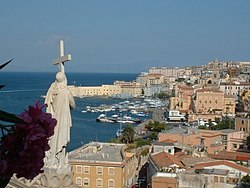Gaeta
| Gaeta | |
|---|---|
| Comune | |
| Comune di Gaeta | |

Gaeta's historic quarter from Monte Orlando.
|
|
| Location of Gaeta in Italy | |
| Coordinates: 41°13′N 13°34′E / 41.217°N 13.567°E | |
| Country | Italy |
| Region | Lazio |
| Province / Metropolitan city | Latina (LT) |
| Frazioni | Arenauta, Ariana, Fontania, Porto Salvo, Sant'Agostino, Sant'Erasmo, San Vito, Serapo |
| Government | |
| • Mayor | Cosmo Mitrano (PdL) |
| Area | |
| • Total | 28.48 km2 (11.00 sq mi) |
| Elevation | 2 m (7 ft) |
| Population (9 October 2011) | |
| • Total | 20,762 |
| • Density | 730/km2 (1,900/sq mi) |
| Demonym(s) | Gaetani |
| Time zone | CET (UTC+1) |
| • Summer (DST) | CEST (UTC+2) |
| Postal code | 04024 |
| Dialing code | 0771 |
| Patron saint | Saint Erasmus |
| Saint day | 2 June |
| Website | Official website |
Gaeta (Italian pronunciation: [ɡaˈeːta]; Latin: Caieta, Ancient Greek: Καιέτα) is a city and comune in the province of Latina, in Lazio, central Italy. Set on a promontory stretching towards the Gulf of Gaeta, it is 120 kilometres (75 miles) from Rome and 80 km (50 mi) from Naples.
The town has played a conspicuous part in military history: its fortifications date back to Roman times, and it has several traces of the period, including the 1st-century mausoleum of the Roman general Lucius Munatius Plancus at the top of the Monte Orlando.
Gaeta's fortifications were extended and strengthened in the 15th century, especially throughout the history of the Kingdom of Naples (later the Two Sicilies). Present day Gaeta is a fishing and oil seaport, and a renowned tourist resort. NATO maintains a naval base of operations at Gaeta.
It is the ancient Caieta, situated on the slopes of the Torre di Orlando, a promontory overlooking the Mediterranean Sea. Gaeta was an ancient Ionian colony of the Samians according to Strabo, who believed the name stemmed from the Greek kaiétas, which means "cave", probably referring to the several harbours. According to Virgil's Aeneid (vii.1–9), Caieta was Aeneas’ (another legend says Ascanius') wet-nurse, whom he buried here.
...
Wikipedia

